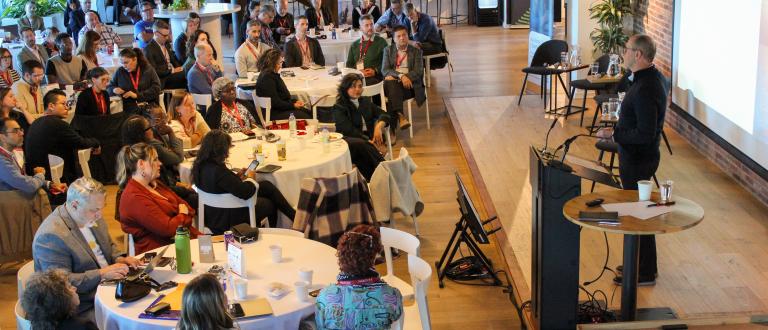Photo caption: The Raw Carrot is a social enterprise employing individuals with disabilities to cook and package handcrafted gourmet soup that is sold in farmers markets and retail locations in the local community.
Budget 2021 was a remarkable one for many reasons, not least of all because it was delivered by Canada’s first female finance minister after a year marked by health, economic and social crisis. For the nonprofit sector, this budget represented a remarkable moment that showcased the considerable progress that we have made in advancing our relationship with the federal government in just the last year. It’s important to acknowledge that this budget did not deliver on all of the nonprofit sector’s priorities, that many organizations continue to struggle, and that we need to continue to advocate for support for the sector through this difficult period. Nonetheless, when compared with federal budgets in recent memory, it’s clear that Budget 2021 marks an encouraging step forward. In a recent blog post, we examined the nonprofit sector’s advocacy efforts since the onset of the pandemic and some of the key results we’ve seen. In this piece, we’re revisiting Budget 2021 (now that we’ve had a chance to fully reflect on all 700+ pages!) to discuss what the announcements mean for charities and nonprofits.
Might benign neglect be a thing of the past?
In many ways, Budget 2021 was the culmination of a year of intense and consistent lobbying, advocacy, and relationship building. Given the diversity of nonprofits and charities, reactions to the budget naturally varied. Some sub-sectors were disappointed specific measures were not included and others applauded new initiatives but lamented insufficient funding dedicated to those measures. Our team, however, has analysed the budget holistically in terms of its inclusion of nonprofit sector issues and concerns, and found numerous positive signs, especially when compared to previous federal budgets.
Notably, Budget 2021 included a section entitled Helping Charities, Non-profits, and Social Purpose Organizations Grow, which explicitly recognized the importance of our sector and the government’s responsibility to support it: “Canada’s charities, non-profits, social enterprises, and other organizations provide vital services to our communities, including to the most vulnerable members of Canadian society....As we navigate our recovery, we must also bolster Canada’s thriving social sector so that we can build healthy, resilient, and inclusive communities across the country.” It is clear that, largely as a result of the sector’s advocacy over the past year, the government recognizes the value of our sector in a way that they did not before.
Targeted measures for charities and nonprofits
The budget also included numerous measures intended to assist the nonprofit sector, including the extension of the Investment Readiness Program and consultations on the disbursement quota. Several sub-sectors received targeted investments, such as new funding for the Local Food Infrastructure Fund and the creation of a new LGBTQ2 Projects Fund.
The $400 million Community Services Recovery Fund is a crucial victory because of its focus on core operating support. The turn to project-based funding for the sector over the last two decades has led to capacity challenges for organizations, and these have in many ways been exacerbated over the course of the pandemic While the funding will be dedicated to modernization and adaptation rather than stabilization, we do have confirmation that the fund was created in response to the sector’s advocacy efforts. We are also pleased to note that it appears that the fund will be available to a broad swath of the nonprofit sector, rather than targeting any one subsector. This is important because it shows a recognition on the part of government that all kinds of organizations, not just those on the frontlines of the pandemic, contribute to vibrant communities and deserve support.
The creation of the Black-led Philanthropic Fund is another great example of the power of advocacy. We’ve heard that the fund was created at least partially in response to Unfunded: Black communities overlooked by Canadian philanthropy, a report by the Network for the Advancement of Black Communities and Carleton University’s Philanthropy and Nonprofit Leadership program. In the lead up to Budget 2021, more than 200 Black-led and Black community-serving organizations signed a statement that asked for, among other things, “support to relieve Black-led community-based service providers on the frontlines of the crisis working diligently to ensure that critical needs of our communities are being met.” While there is still much work to be done to ensure equity for Black-led and Black community-serving organizations, the creation of this fund was a sign the government is paying attention to critical gaps in our sector’s funding environment.
Recognition of nonprofits as part of the broader economy
The nonprofit sector is often arbitrarily excluded from measures created for businesses, but Budget 2021 the nonprofit sector was included in numerous measures including the new Canada Recovery Hiring Benefit, from the outset. The sector also stands to benefit from the extension of the Canada Emergency Wage Subsidy, and Canada Emergency Rent Subsidy. We hope this marks the end of the need to reactively advocate for inclusion in every new program or initiative targeting employers. If so, it will allow the sector easier access to support and allow those working in policy to focus on other priorities.
Additionally, the nonprofit sector was not forgotten in one of the government’s signature Budget 2021 promises; they committed to “working with provinces and territories to support primarily not-for-profit sector child care providers to grow quality spaces across the country while ensuring that families in all licensed spaces benefit from more affordable child care.” This is notable not just because nonprofit child care providers will now have access to $27.5 billion in funding over the next five years, but because it is a clear recognition of the value nonprofit organizations bring on to a key policy priority.
More developments to keep an eye on
The government has introduced a new quality of life analysis to measures announced in Budget 2021. This lens of analysis aims to provide a more holistic view of the impacts of new initiatives compared to the traditional purely economic lens. It is sometimes difficult - and often inadequate - to quantify the impact that an organization has on its community in purely economic terms, so this is an opportunity for our sector to communicate our impact within a new framework better suited to capturing social and environmental benefits.
Budget 2021 included numerous measures related to data that may have an impact on charities and nonprofits. The government is investing $172 million over five years to create a Disaggregated Data Action Plan that will fill data and knowledge gaps. It is unclear whether the Action Plan will include measures to fill data gaps about the nonprofit sector itself, but in any case increased availability of disaggregated data will be invaluable to many organizations looking for detailed information about the populations they serve.
Two of the government’s Budget 2021 commitments may also increase momentum related to direction and control reform. The government is aiming to disburse money to nonprofit organizations through the Community Services Recovery Fund and the Black-led Philanthropic Fund, but this will be difficult given that these organizations are not qualified donees. We are hopeful that these two initiatives will act as an impetus for change on this important file as the government confronts its own regulatory barriers while needing to deliver these ambitious programs on tight timelines.
Where we go from here
Over the past year, so many individuals and organizations have gotten involved in nonprofit sector policy issues and devoted time and energy to advocating for our organizations. We’re proud of what the sector has accomplished by working together and feel it’s important to mark the progress we’ve made. With case counts falling and vaccination rates rising, we may be leaving the acute phase of the COVID-19 crisis behind and entering a new phase of advocacy. As conditions improve, we plan to seize the momentum created over the past year and build on it to create systemic and structural change on our policy priorities. We hope that we can count on the sector to continue to show up and advocate for our organizations and communities, because this last year has shown how strong we are when we work together.


